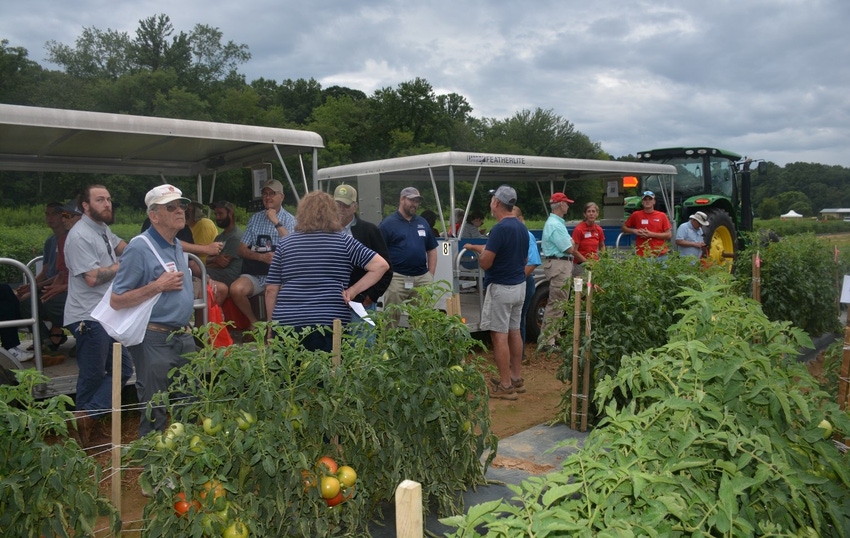
The 225 attendees at this year’s North Carolina Tomato Field Day Aug. 11 at the Mountain Horticultural Crops Research and Extension Center in Mills River had the opportunity to see newly developed lines geared for new production systems, while receiving a refresher course on diseases that continue to challenge farmers across the state.
In one stop, Jamie Lanzalotto, a research technician in the breeding program at the station, highlighted new tomato lines being bred for North Carolina farmers that are designed to be about two-feet tall, offering a compact growth habit. Lanzalotto said these compact growth lines are not staked, which means they don’t need to be strung and due to their plant architecture, they don’t need to be pruned.
“Staking, pruning and stringing before harvest is a little bit over 60% of the labor cost, so eliminating that would be a great savings for farmers down the road. Plants also exhibit concentrated flowering set so when they do set fruit, it’s all at once, so you have one good harvest, maybe two,” Lanzalotto said.
Lanzalotto also highlighted Lanai tomatoes being bred at the station that are designed to be one- foot tall and are ideal for urban growers who want to plant tomatoes in a pot on their porch because the plants don’t need a stake and don’t need to be pruned. Lanai tomatoes also show potential as a nursery crop and for vertical farming, an up-and-coming production system.
Tomato breeder Dilip Panthee highlighted the large-fruited tomato replicated yield trial that consists of 24 hybrids. “The main objective of this trial is to identify superior hybrids with respect to yield potential, fruit quality and disease resistance,” Panthee said.
He also highlighted the plum tomato replicated yield trial that consists of Mountain Crown and Plum Regal as controls. “Three hybrids were replicated from last year’s trial for their excellent performance, and five new hybrids were included as new hybrids for the replicated trial,” he said. “The objective of this trial was to combine the disease resistance and improved fruit quality into the hybrid tomato.”
Panthee also discussed the grape tomato replicated yield trial that includes six hybrids, consisting of four experimental hybrids and two controls, including Mountain Bebe and Smarty. The objective of the trial was to also combine the disease resistance and the fruit quality in hybrid tomatoes.
Disease management was a major focus of the field day. Verticillium wilt is a fungus that survives in the soil for more than 20 years and germinates under temperatures at 80 degrees Fahrenheit. It can go through the root system and start growing inside the tomato plant and can clog the plant so it can’t get water anymore.
Plant Pathologist Andres Sanabria-Velazquez said verticillium wilt is very hard to manage and fumigants are not that effective. He said North Carolina. State University is looking at a soil amendment approach to control the disease that includes adding carbon sources where microbes in the soil can knock out the pathogens.
Tomato spotted wilt virus continues to present challenges to tomato farmers. The virus is spread by thrips and can infect hundreds of different species of plants. It can be difficult to eradicate because it can spread throughout the environment in weeds in surrounding fields.
Kirsten Lahre, a research assistance in entomology and plant pathology, said genetic resistance to tomato spotted wilt virus is an effective control. Resistance can be found in wild species of tomato where breeders cross the resistant genes into cultivated lines of tomatoes.
Inga Meadows, an Extension disease management specialist, said bacterial leaf spot continues to be a challenge because the current fungicides available don’t offer great control. She said the standard product for tomato growers is Mancozeb, a broad-spectrum contact fungicide which is mixed with a copper-based product.
“The problem is that 99 % of our strains that occur on tomatoes are copper tolerant, so the copper alone doesn’t work. It fails. Even sometimes it makes it worse than no treatment at all. What they found in the 1980s when they mix it with Mancozeb, which is a broad-spectrum fungicide, we have a little bit more activity against those copper resistant strains,” she explained.
When the two products are mixed, there is a little bit better control, but Meadows emphasized that control is not that great, particularly under high disease pressure. She said the release of Actigard in the 2000s provided one more tool to manage bacterial leaf spot. Actigard is not acting on the bacterium, but is inducing a host response.
“The problem with Actigard is that because it is inducing a host response, you can get some yield drag if you use too much of it, so it’s a fine line type of thing. I think we’ve scaled it down to where we are recommending a proper dose for control where we’re not hurting yield,” she said.
About the Author(s)
You May Also Like






